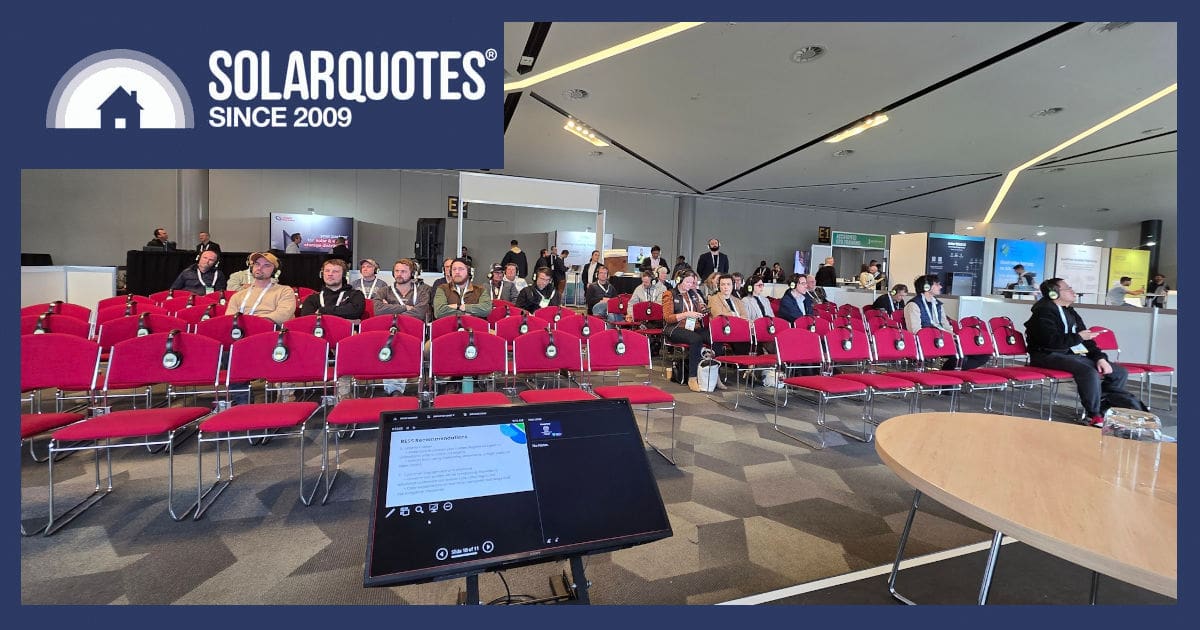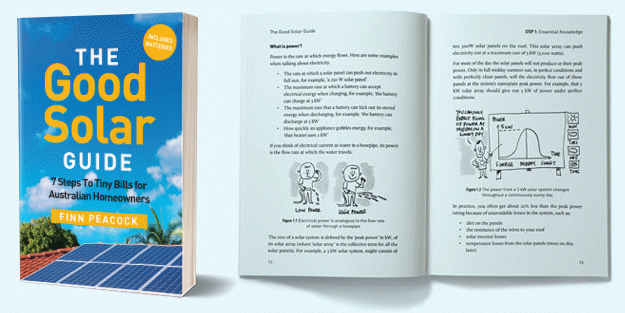Recently the Smart Energy Council held a conference in Adelaide and by all accounts it was a roaring success, much like the battery incentive that’s currently driving the whole solar industry.
When the SEC said they were looking for industry experts to offer some insight, I figured they’d emailed me by mistake, but I went along anyway with some images to riff off of and enough notes to wing it for 15 minutes of fame.
Hopefully, nobody recorded this session because I couldn’t jam 30% more material into the 10 minutes I’d been allotted, however unfunny, everyone seemed to nod along in their headphones. The routine was well received and we even had a couple of good questions at the end. There were some points around how the home electrification industry needs to do better on customer education that I thought were worth detailing here.
People Need To Be Brought Up To Speed
When you’re sick of cleaning your gas cooktop and inhaling it’s carcinogens, there’s nothing to stop you installing a timber frame and an induction top for far less than a whole new cooker.
All the recent interest in batteries, getting off gas and other trends has seen home electrification finally go mainstream, and from my anecdotal observations, it’s the ones who were busy peeling glue off their hands or reading the football fixtures in science class that need the most help.
Or perhaps its all the toxins they are inhaling from their gas cooktop they refuse to upgrade. But with gas and electricity prices continuing to rise, the ones who’ve held out, ignored or put off doing something are now finally getting on with it. The trouble is, they’re ripe for being exploited by energy and building sectors that take them down the wrong path.
Solar Changed The Game For Energy Companies
This system was a big deal in its day, but is getting a little dated now, so the battery rebate may see it replaced.
Years ago, when panels were 195W each, their frames were a very stout 40mm deep and exclusion zones were something to be gleefully ignored, the system pictured above was king of the kids.
I thought this customer would go “crazy” and put an enormous 10kW on the roof, but as a joke we measured it for about 17kW. Things got real when he texted back “let’s do it” and we had to make it fit.
Challenge accepted, we landed on 5 strings of 19 panels for 18.5kW and as far as the electricity industry was concerned, this guy didn’t just swap retailers, he disappeared completely.
For Big Electricity™ a reliable $2000 – $3000 per quarter income stream vanished and those savings quickly paid the system off for the customer.
However as rates have risen and the introductory 16c/kWh feed in tariff trailed off, the bills have returned.
Big Electricity™ Isn’t Helping
Due to this, many previously happy solar customers are now ringing up to complain their system “isn’t working” and they book a service call to get things diagnosed. That’s good because a little maintenance is sometimes needed, as our latest video explains.
However, when there’s no electrical fault or shade issue, it turns out the part which “isn’t working” is the bill from the retailer.
At this point a solar electrician really needs to go into bat to make sure people understand how the whole electricity industry works.
Obviously, billing for kilowatt-hours isn’t sustainable when your customers are generating most of their own. With large fixed costs to meet, retailers (& networks) are raising rates all over the place and making the plans they sell so complex they’re opaque.
This design means they hope you’ll simply give up and just resign yourself to paying, which makes energy companies a justifiable target for a lot of rage and customer mistrust.
You’re Getting What You Paid For
With the arrival of the rebate plenty of people are turning to batteries to address rising energy costs, but this sector has a responsibility not to take advantage of customer ignorance too. It pains me to see some of these incredibly cheap deals going for solar batteries now, including for batteries that are way too big.
GoodWe is good gear but an oversized 50kWh Neovolt is what my nightmares are made of.
However, I have to reiterate that the cheerfully cheap gear often attracts the dismally cheap installers. While you might luck out with a great trades team, the most important thing with increasingly complex systems is having someone who can set it up right and answer the phone if it goes wrong.
While there are some really good tools available, getting a system just right generally needs some professional advice and training to arrive at, so reach out and we’ll be glad to find someone who can help.
Efficiency Is King
The other group that needs to do better at educating customers on home electrification is builders. I wish I could properly explain to people just how bad Australian building standards are and how builders are just shafting us all.
It’s not just the written standards in the Building Code Australia rule book, it’s the poor standard of workmanship and lack of enforcement meaning the finished building doesn’t even live up to the lax rules.
The fundamental design of this place pictured below is rubbish. A box gutter liable to leak. Low pitch with no ventilation of the roof cavity. Metal framing to carry heat straight through whatever insulation I’ll bet is badly installed.
Huge ducts outside the insulated envelope, so the HVAC is effectively outside in the shed.
I watched the HVAC contractor stripping insulation off this duct so it would fit through a thoughtlessly designed truss.
New and old builds alike suffer from people who don’t care about putting insulation back where it belongs and making sure there are no gaps.
Everything Pointed In The Wrong Direction
Despite the rising cost of energy, builders make houses bigger, more complex and harder to work on. I’ve written before about roofing and getting things right.
However plans like this keep coming across my desk, where the appearance from the street is all that matters and the actual cost to own the place is a distant third to what the Jones’ might think and how cheap the builder can make it.
There’s at least 8 corners and a dozen hips, ridges and valleys this place doesn’t need.
I don’t want a formal entry, home theatre, double kitchen, double vanity, double bathroom with a laundry I can’t swing the cat in.
So why don’t we demand a garage with a floor drain; which has the laundry, indoor clothes line and a shower to clean your tent/kyak/bike/boots/dog or yourself after a messy outing.
Imagine a utility room for sewing curtains, painting furniture, preserving fruit & jamming with the band. A room you’ll use more than any other because it serves as an airlock between the outside and your conditioned space.
There’s so many ways that education of customers can lift, or at the very least the energy and building sectors could stop capitalising so much on their ignorance.
For more, read my pieces on insulating your home if your builder didn’t bother, and on how electricians can opt out of the race to the bottom on dodgy battery offers.


 RSS - Posts
RSS - Posts



ah yes, the “quality” Australian building market. You forgot the other big issue with modern housing – the estate covenants forcing you to build a McMansion even if you and your spouse are retired and want to downsize to a right sized house.
If you can find an estate that will let you build a small house, there are various levels of government that want to tax the bejesus out of you if you do have the hide to want to downsize your house – then the dodgy Builders and Tradies to be dealt with at the end of that line that DO NOT want to build an efficient house.
Smart Energy also means smart load scheduling.
Helpful things include:
– Aligning Hot Water heating with PV Production.
– Making the most of PV production to heat/cool your home.
– Running dishwashers, washers and dryers during the day.
– Being informed about how power appliances are using and how you consumption looks during the day. I have a Google Nest Hub configured to show PV production, Consumption, Grid Import, Available Battery Capacity, current price, if the demand window is active, along with current import and export price (I’m with Amber). It’s in the kitchen and is laid out in such a way it’s easy for all members of the house to understand how the consumption will affect our power bill.
Not having time to bone up on Home Assistant yet, load scheduling is still manual here, Craig. With clear skies at breakfast today, the BEV took 16.5 kWh to top up in 2.5 hrs, and the HWS is still cooking after 2 loads of washing. The latter is automatically sunny-weather-only, as I dry on an outdoor clothesline. (The clothes pile in the basket is then a deferred-energy store, as good as a battery.)
With 46 kWh of battery, and 6-stars insulation, a little 3.5 kW RCAC kept indoors at 24°C last night, with 12°C outside – drawing only 0.7 kW. Ample battery and insulation means that heating requires zero planning, and two fridges are no issue. My big old single-glazed place in the Dandenongs was impossible to keep warm in winter – thermal design is *the* solution – only then heaps of solar, that teaches me. (At least in winter.)
Being on-grid, with 3 free hours daily, would be liberating, as local overcast ceases to be an impediment then – nifty if you have it.
Great piece as always Anthony, thank you.
I’m wondering if larger FiTs may be back in future. Obviously a mechanism to promote solar uptake until now, and that job is done. And now wound back because of a glut of supply. But down the track I reckon the superabundance of renewable energy that is talked about (oversizing the grid to cope with fluctuations in generation) will also induce new demand, as we’re already seeing with some mining firms. That might make supply to the grid an in-demand thing again?
Not that I’m banking on it, my system will pay for itself before any of that comes to pass. But the evolution of the grid made me wonder.
I agree home builders need to work on roof designs to make it easier and cost effective to put up solar and do maintanance. Your image showed how stupid a roof top install can get. Home designers have a lot to do with current state of our housing problems. Watching some builders working on sites next to us they do not care either.
😲 “there is nothing stopping you” I’m sorry but there is a little thing called LPG that may still be connected! And as i tell everyone when doing gas inspections and certificates, there is not a 100% guarantee that the valve will turn off correctly! Ever seem a leaking water tap that you have turned off as tight as you can and it still drips 🤔 if you are thinking about doing this? Please make sure you get a licened gas Fitter in to disconnect the appliance and isolate it properly. 👌
What is needed is a council (or Shire depending where you are) owned VPP, essentially a deployment of “Home Battery” equivalents to Public Spaces like Play grounds.
The councils typically have Electricity Grid connections to these public spaces for the irrigation and public lighting. Hence deployments can be designed within the existing constructions limits.
The Public Spaces are spread out in the communities and being closer to the solar excess and peak demand will reduce the losses associated with the grid.